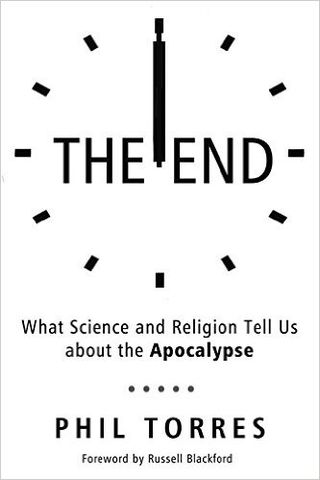Religion
Exploring Our Endless Obsession With the End
Author Phil Torres discusses science, religion, and doomsday.
Posted February 17, 2016
Explore the shelves of any typical bookstore today and one finds many books that touch upon humanity’s demise in one way or another. The fall of civilization, economic failure, pandemics, environmental collapse, nuclear war, and human extinction are all hot topics. Even Young Adult sections are well stocked with novels about teenagers struggling against various versions of the end. I recently found no less than three visually impressive magazines catering to people who want to be prepared when doomsday arrives. Film and television studios routinely invest heavily in the end, of course, offering up stories about everything from planet-busting asteroids to gluttonous zombies.
Apocalyptic hopes and fears are nothing new. This is an obsession that is likely as old as we are or close to it. “We’re doomed” was probably one of the first prehistoric memes.
Phil Torres thinks we need to make a greater effort to understand doomsday in order to better understand ourselves—and hopefully dodge any real ones. The Institute of Ethics and Emerging Technologies affiliate scholar is the author of a fascinating new book, The End: What Religion and Science Tell Us About the Apocalypse. Here he answers eight questions to help shed some light on one of our darkest and most enduring obsessions.
Why is the idea of a doomsday so popular?
Phil Torres: Apocalyptic thinking forms the background to much of recorded history. Both Christianity and Islam probably began as apocalyptic movements, and highly influential “secular” ideologies like Marxism and Nazism were founded on millenarian promises. Today, about 41 percent of Americans believe that Jesus will either “definitely” or “probably” return by 2050, and comparable numbers of Muslims expect the world to end in their lifetimes. There are also singularitarians in Silicon Valley that anticipate a quasi-utopian state after the “Singularity” occurs in 2045. And of course doomsday themes are common in popular culture, including film and music. Just about everywhere one looks, one finds apocalypticism bubbling beneath the surface!
What surprised you while researching and writing The End?
The extent to which apocalypticism pervades human culture across space and time, history and geography, was surprising to me. All one needs is the right glasses to see this ubiquitous phenomenon. In fact, many scholars of apocalyptic movements habitually lament that the subject is neglected by both academics and the public. Some have even argued that the most significant struggles throughout history, and in our present era, have been nontrivially fueled by antagonistic eschatological beliefs. In The End, I refer to this as the “clash of eschatologies” — a phenomenon I distinguish from Samuel P. Huntington’s famous “clash of civilizations.”
Do irrational end-of-the-world claims make the public less likely to take seriously more realistic threats such as an asteroid strike, nuclear war, or a killer virus?
The long history of prophetic failure in religious traditions does lead some to dismiss the warnings of scientists. People say, “Yes, but every generation has thought that it’s the last.” What’s crucial to recognize here is the epistemological difference between religion and science. Whereas religious prophecies are based on faith and revelation, the warnings of scientists come from evidence and reason. In a phrase, wise people always proportion their fears to the evidence. And when the evidence is honestly examined, the risk of an existential catastrophe appears surprisingly high — perhaps close to 50%, according to Sir Martin Rees.
Just how fragile are we? There are more than seven billion of us and we are extremely smart and creative. It seems our extinction would take some real work.
To be sure, eliminating every last human would be an extraordinary event. Consider the uncontacted tribes in the Brazilian Amazon or the roughly 60 people living in Las Estrellas, Antarctica. Yet some of the doomsday scenarios that have been proposed, such as the “gray goo” scenario (nanotechnology run amok), really are global in scope, meaning that they’d affect everyone on Earth. Others, like a catastrophic vacuum decay, could be genuinely cosmic. It’s also worth noting here that an “existential risk” need not have terminal consequences. There are some existential risk scenarios that are survivable, yet they result in an irreversible drop in our life-quality or potential to reach a “posthuman” state.
What worries you more, religious terrorism or emerging biotechnologies?
I don’t think this is an “either/or” situation. Religious extremism is now the primary driver of terrorism in the world, and apocalyptic groups from Aum Shinrikyo in Japan to the Islamic State in the Middle East have seen it as their religious duty to weaponize microorganisms. Indeed, a central thesis of The End is that we’re entering a new era in which “archaic” belief systems are on a collision course with “neoteric” technologies, including biotechnology, synthetic biology, robotics, and nanotechnology. And the consequences could be genuinely catastrophic. Unless the rationality of our ends matches the rationality of our means, we could be in big trouble.

What are the top threats to human life in this century?
We should recognize right away that the top existential risks aren’t the top global catastrophic risks. By definition, the former cannot be recovered from, whereas the latter can. I would argue that superintelligence is the most significant known risk to the long-term survival of humanity, but that it’s something of an “all-or-nothing” threat. If it doesn’t kill everyone, then it probably won’t kill anyone. Climate change, on the other hand, probably won’t result in our extinction, but it will almost certainly have catastrophic consequences of global proportions. The number one threat to our future, though, is probably an “unknown unknown,” or what I refer to in The End as a “monster.”
What would a near extinction-proof human species look like?
Peering across the vast history of apocalyptic activism, it’s not clear to me that humans are responsible enough to handle increasingly powerful new technologies. The fact is that we’re no longer children playing with matches, we’re children playing with flamethrowers. This is why some transhumanists claim that the best way to survive is to actually go extinct — not in the sense of dying out completely, but by replacing Homo sapiens with a new and “better” species: Posthumanus sapiens. Other possibilities include space colonization, underground bunkers, and superintelligence, the latter of which Stephen Hawking and others describe as the best, if not the worst, thing to happen to humanity.
What can we—typical, everyday people—do to help humankind avoid the end?
The number one activity that everyday people can do is study basic epistemology. This may sound odd or pedantic, but we simply can’t expect to navigate the wilderness of big-picture risks before us if our beliefs about the world aren’t properly hinged to reality. Indeed, most of the biggest dangers that haunt our collective future are entirely avoidable. But to solve these global problems, humanity must divest itself from change-resistant dogma and blind ideology, and instead embrace a philosophy of critical thinking. Evidence is our very best “guide to truth,” and without true beliefs about reality, our chance of dying in wilderness could be high.
For more about Phil Torres and his work, visit the X-Risks Institute and the Institute of Ethics and Emerging Technologies. Contact him at philosophytorres@gmail.com .
Guy P. Harrison is the author six books that promote science and reason, including Good Thinking: What you need to know to be smarter, safer, wealthier, and wiser




